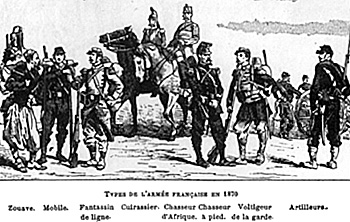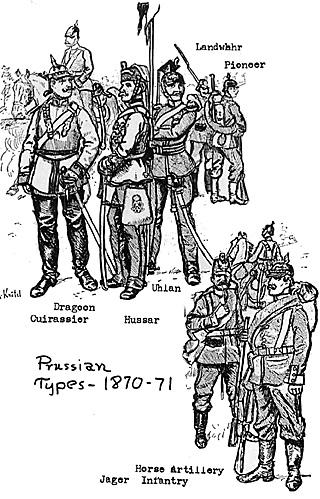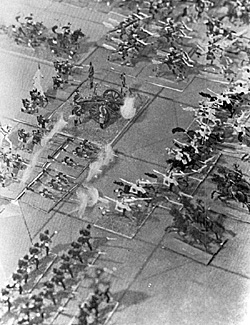 The Franco-Prussian War, last of the three wars waged by Bismark to
create the German Empire (The Second Reich, as it would later be remembered)
was also the last of wars between major powers in which the contestants wore
uniforms designed to be seen rather than those designed to keep the wearer
inconspicuous.
The Franco-Prussian War, last of the three wars waged by Bismark to
create the German Empire (The Second Reich, as it would later be remembered)
was also the last of wars between major powers in which the contestants wore
uniforms designed to be seen rather than those designed to keep the wearer
inconspicuous.
Like the 1864 and 1866 wars, the war in 1870-71 was pretty much a one sided affair. The Prussian army, with those armies which had been added to hers in the North German Confederation, was more numerous, moreover, its artillery was more powerful, and its cavalry much more effectively used than that of the French. The French infantry, however, had the chassepot, a superior shoulder arm, and was composed of a great many veterans of wars in Italy, Mexico, and North Africa. Inevitably, therefore, though not well led as regards strategy, the French army could not be walked over, and inflicted, prior to the Emperor's capitulation at Sedan heavier losses in killed and wounded than it received.
Both Prussia and France were fielding armies as colorful as those of any other period, including the Napoleonic. Both monarchs had their "Guards", while on the German side the lesser princes of the North German Confederation sent their own household troops.
 French
French
The French Guards, who would be forever abolished after the Sedan debacle, entered the war with 21,949 men, 72 guns, and 6,635 horses, forming the following units:
Infantry
- 1 Grenadier Division of 3 regiments of 3 battalions each
1 Voltiqueur Division of 4 regiments of 3 battalions each
1 Zouave Regiment of 2 battalions
1 Chasseur a Pied Battalion
Cavalry
- 1 Regiment of 4 squadrons each of the following types: Cuirassiers,
Carabiniers, Lancers, Dragoons, Guides, Chasseurs a Cheval
Artillery
- 2 Regiments, 1 of horse, 1 of field, each having 6 batteries of 6 guns
each battery.
In addition, the field army at the outbreak of war could field 100 regiments of 3 battalions each of line infantry, 20 chasseur battalions, 3 regiments of Zouaves, 1 of Algerian light infantry, 3 of Algerian riflemen, 1 Foreign Legion regiment. The battalions had 6 field and 2 depot companies in most cases.
The line cavalry had 10 cuirassier regiments, 12 dragoons regiments, 8 lancer regiments, 12 chasseur a cheval regiments, 8 hussar regiments, 4 chasseur a cheval d'Afrique regiments, and 3 regiments of robed and turbaned Spahis.
The artillery of the line had 15 regiments of field artillery and 4 regiments of horse artillery, each having 8 batteries of 6 guns each. By German standards the artillery had too few men and horses per gun.
Of the 368 battalions, 252 squadrons, 984 guns, and 3 Engineer regiments of the French field forces, 36 battalions, 40 squadrons, and 60 guns were pinned down at Civita Vecchia, on the Spanish Frontier, and in North Africa, leaving 332 battalions, 220 squadrons, 784 guns (after mobilizing further detachments) massing on the Rhine by early August, 1870.
 German
German
The German forces, which mobilized more slowly, were able to prepare for the coming danger because the French command was reluctant to take the offensive in more than token fashion. By early August 3 German armies and various independent formations totalling some 474 battalions, 382 squadrons, and 264 batteries were preparing for the great offensive.
Both of these belligerents entered the war with peculiar gains and losses from their recent battlefield experiences.
In 1866 the Prussian infantry armed with the Dreyse "Needle Gun" had virtually won the short war single handedly. The Prussian cavalry had been outfought, and the artillery badly handled. To correct this the Prussian cavalry had been retrained to range in aggressive masses ahead of the infantry, with small scouting parties out on all sides. The artillery had been entirely equipped with the Krupp breech loading rifled cannon, whose rate of fire and accuracy were much improved. Moreover, the artillery was prepared to move up with the infantry.
France, whose La Hitte system 4 and 8 lb. bronze muzzle loading rifles had come as a dramatic surprise to the Austrians in 1859, was rather less concerned about her artillery, but after the surprising success of the Dreyse, she worked overtime to improve the small arms firepower of her army. As a stopgap the Montigny mitrailleuse, or "Canon a balles", a crude machinegun on an artillery carriage was introduced as a battalion gun to put French battalion, using muzzle loading rifles, on an even footing with a Prussian battalion. In 1867, besides putting the dragoons in blue instead of the traditional green, and otherwise simplifying the uniform, Napoleon III's army was re-equipped with the chassepot rifle for infantry and the chassepot carbine for light cavalry, dragoons, and artillery. The chassepot had a tighter breech than the Dreyse, and could be used as effectively at 1,200 yds as the Dreyse at 800 yds., although truly accurate ranges were somewhat less in either case.
The French, on the whole, relied more on defensive positions and skirmishers. They had correctly assessed the difficulty of advancing against rapid fire weapons, but were unable to incorporate the new firepower into a scheme of maneuver. In the open the soldiers and subalterns were aggressive enough, acting in loose lines and swarms of skirmishers.
The Prussians and their allies of the North German Confederation relied on tight company columns for tactical maneuver, with swarms of skirmishers for fighting. Their infantry fire discipline was excellent when compared to that of the French, although in the early battles, the latter showed a good deal more dash and firepower in skirmish actions. French infantry, because its fire discipline, and discipline in general was weaker, was more vulnerable to surprise by cavalry than was the German, but somewhat superior in straight infantry fighting before the artillery intervened.
On both sides the cavalry relied heavily on sword and lance, the French showing perhaps more of a tendency to fight on foot or to fire their carbines from the saddle, and some illustrations show chasseurs a cheval with what appears to be a full length weapon. In any case, this tendency sometimes payed off in broken ground and was probably due to the fact that the German cavalry weapon was depressingly inaccurate. The French were also prone to stay in large parties and stick close to the infantry, not because they feared the German horse, but because small parties were often wiped out in North Africa and Mexico, while large ones could usually ride over the opposition.
Cuirassiers on both sides wore steel helmets, breastplates, and were armed only with sword and pistol. The French lanciers and German Uhlans were also armed only with pistols and cold steel, an on the theory that shoulder arms rob the cavalry of dash.
In the German service cuirassiers were heave, uhlans medium, dragoons and hussars light. The division normally had 6 regiments of 4 squadrons each, supported by a battery of 6 horse guns and usually formed in 3 brigades. The brigades were of different "weight", i.e., cuirassiers, uhlans, and light horse frequently appeared in the same division. Sir Frederick N. Maude's article on cavalry in the famous 1911 Encyclopedia Britanica suggests that this system was exclusively for recruiting and maintenance, since light, medium, and heavy cavalry move at different speeds and have different functions, but such does not appear to have been the case, since Bredow led out a brigade which included the 7 Cuirassiers and 16 Uhlans in his famous death ride. Each major formation was expected to have some light horse for scouting and if (heaven forbid) some necessity for dismounted action arose.
Light cavalry also performed services of reconnaisance and close support for infantry divisions, and, owing to the difficulty of concealing larger bodies of cavalry near the front, the divisional squadrons were often the only ones able to get in on the pursuit. Except in rare cases, the French neglected scouting and screening for the infantry, and saved the cavalry for spectacular and highly unsuccessful charges on the battlefield.
As a result, the French army, with its aggressive and well equipped infantry hampered by relatively ineffective artillery and cautious tactical doctrines, got little successful use of its cavalry. On several occasions (twice with 2 cuirassier divisions at Foreschwiller) French cavalry was thrown at the enemy to cover a maneuver of the infantry, usually retreat. The cavalry attacks did slow the Germans down, for it was the custom of the German infantry to halt, form up in triple line and wait until the charge was about two or three hundred yards away and shoot the hell out of it. Sometimes the Germans just stopped whatever else they were doing and received the charge at close range from any convenient obstacle. The only trouble with slowing down the Germans that way was that the same Germans would soon be at it again, but you could only use the same cavalry against them once, since so little of it came back.
 Vionville
Vionville
At Vionville the pick of the French cavalry got into an involved brawl with an about equal force of crack German units and the two masses slammed about for some time before the French, then the Germans, sorted themselves out and retreated in different directions, one French force following the retiring Germans at a discreet distance. The chief result was that some years later, on studying their casualty reports, the Germans found that the heaviest loss rate had been inflicted by the French Guard Lancers on the Oldenburg Dragoons, and this was one of their reasons for equipping all of their cavalry with lances in preparation for World War I. Some, of course, may conclude that the lance was added because the Kaiser thought lance penons enhanced the martial splendor of cavalry parades, but a lot of thought apparently went into the decision.
For wargamers the best way to get cavalry into an 1870 game is to use it well ahead of the main armies. True, the French cavalry was usually kept back, but one need no duplicate all of the historical mistakes of the losing party. The role played by superior Prussian horse artillery, if the weapons difference is taken into account, may well be matched by mitrailleuses clattering along behind the squadrons of red legged lancers, cuirassiers, dragoons, chasseurs, and hussars.
The question of differentiating weapons versus giving both parties an equal technological situation has two sides. My own games have always standardized, but since the actual advantages and disadvantages were somewhat balanced, it may be preferable to allow for them, as does Henry Bodenstedt's game.
Other Franco-Prussian War
Back to The Armchair General Vol. 1 No. 6 Table of Contents
Back to The Armchair General List of Issues
Back to MagWeb Master Magazine List
© Copyright 1968 by Pat Condray
This article appears in MagWeb (Magazine Web) on the Internet World Wide Web. Other military history articles and gaming articles are available at http://www.magweb.com
